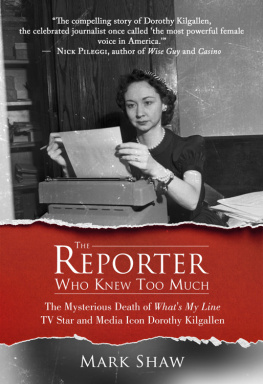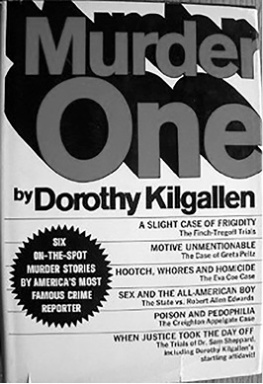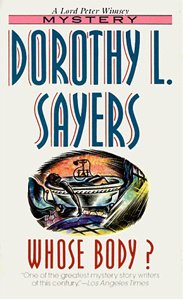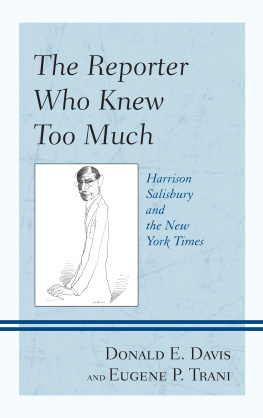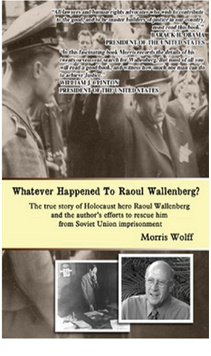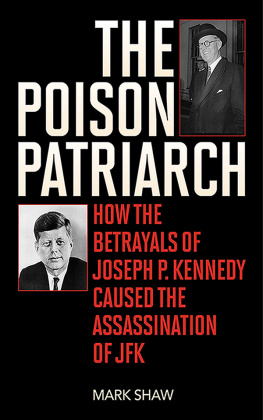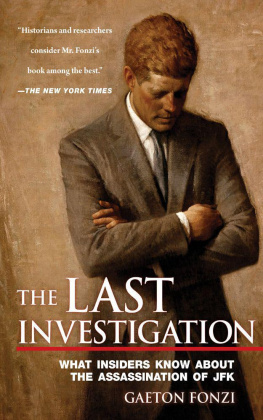A POST HILL PRESS BOOK
The Reporter Who Knew Too Much:
The Mysterious Death of Whats My Line TV Star
and Media Icon Dorothy Kilgallen
2016 by Mark Shaw
All Rights Reserved
Cataloging-in-Publication data applied for.
ISBN: 978-1-68261-097-8
ISBN (eBook): 978-1-68261-098-5
Cover Design by Quincy Alivio
Cover Photograph courtesy of Corbis Images
Interior Design and Composition by Greg Johnson/Textbook Perfect
No part of this book may be reproduced, stored in a retrieval system, or transmitted by any means without the written permission of the author and publisher.

Post Hill Press
posthillpress.com
Published at Smashwords

C HAPTER 6
I n late 1956, Dorothy Kilgallen made a deadly enemy when she began to carry on a public feud with Kennedy family friend and Mafia-connected singer Frank Sinatra. He was inflamed after she wrote a Journal-American series titled The Real Frank Sinatra Story.
In her articles, Kilgallen detailed Sinatras various romances with, among others, Gloria Vanderbilt, Kim Novak, Lana Turner and Ava Gardner. She added:
A few of the women, like Ava and Lana, were public idols themselves and priceless examples of feminine beauty. Many more, of course, have been fluffy little struggling dolls of show business, pretty and small-waisted and similar under the standard layer of peach-colored Pan-Cake makeup. [They are] starlets who never got past first base in Hollywood, assorted models and vocalists, and chorus girls now lost in the ghosts of floor shows past. Others belonged to the classification most gently described as tawdry.
In turn, Sinatra derided Kilgallens chinless appearance. She responded by writing about his Mafia connections. This included associating him with Chicago gangster Sam Giancana and L.A. crime boss Mickey Cohen. One evening, Sinatra walked by her at the Stork Club. Noticing that she was wearing sunglasses, he dropped a dollar bill in her coffee cup. Then he said to a friend, I always figured she was blind.
Sinatras antics irritated Kilgallen but she disregarded them to celebrate Richards 46th birthday hosted at New York Citys Plaza Hotel. Kilgallen surprised guests by accepting an invitation to dance with entertainer Bobby Short, an African-American cabaret singer and pianist best known for his interpretations of songs by popular composers of the first half of the 20th century.
Onlookers who objected to any interaction between the races were thunderstruck by Kilgallens audacity. She did not care. Bobby Short was a friend; she was ready to break down barriers; skin color made no difference to her.
During this time, Kilgallen was truly a household favorite. Various commercial opportunities abounded, and she took advantage of them. One involved print ads pitching her as enjoying flights on a particular type of airplane. The ad copy, next to a beaming photograph, read, For business or pleasure, I fly DC-6.
Kilgallens star power stretched to family members. Even though he did not bear the magic Kilgallen name, oldest son Richard hit the ad scene as well. Double Bubble bubblegum hired him to pitch its product to the younger set.
Despite Richards financial downturn, Kilgallens earnings from the commercials, Whats My Line?, the Voice of Broadway column, the Dick and Dorothy radio program, and other endeavors permitted the family to live well. Home was the lavish five-story townhouse located on the upper east side of Manhattan featured on CBSs Person to Person. It featured an Otis elevator and front and rear staircases. There was a reception area on the ground floor next to a large powder room and a small mailroom. The bottom flight of the main stairwell was nearby. Gazing straight up permitted the view of a roof top skylight.
During the Christmas season giant snowballs, giant snowflakes, and colorful ornaments hung from the top over the staircase. In the room featuring furniture from the Gone With the Wind set, French doors, chandeliers, and expensive art completed the dcor. There was only one electric light in the room with candles spread throughout.
Despite marital problems, Dorothy and Richard were truly societys darlings. The couple hosted lavish parties. Entertainer Steve Allen said, Everybody who was anybody was at Dorothys parties. Guests included Jayne Mansfield and George Harrison of Beatles fame.
During the holiday season, Dorothy and Dick hosted a fancy Christmas tree-trimming extravaganza and New Years Eve Costume Ball. Separate rooms became decorated nightclubs. When guests dressed as movie stars and other celebrities entered these rooms, they gasped. There Judy Garland, the Count Basie Orchestra and other friends of the Kollmars performed. One year, Dorothy dressed as Scarlett OHara and Richard as Rhett Butler. At these parties, Kilgallen was the champion at word games and charades.
All the while, Kilgallens love affair blossomed with sandy-haired singer Johnnie Ray, fourteen years her junior. Fellow columnist Liz Smith called the affair peculiar while adding, Here was this white-gloved Catholic making out with a homosexual all over town.
Kilgallen called An Affair to Remember , the film she and Ray had watched together, a winner. In her column, she wrote that the movie was a tribute to those who are getting tired of pictures about dope addicts, alcoholics, unattractive butchers, and men who sleep in their underwear. In contrast to the hard-edged persona Kilgallen was infamous for, Ray said of her, She was probably the most feminine woman Ive ever known. And I always thought she was a pretty ladythe softest thing you ever touched. All those people that made fun of her. That was just plain sick.
Friend Hank Wesinger said of the couple: [Kilgallen and Ray] were like two little kids. They would go romping off and do their little silly things. Together, they were like two children. They were in love.

C HAPTER 7
U pping the stakes, Dorothy Kilgallen continued to use her Voice of Broadway column to attack Frank Sinatra. She did so in an unabashed, unforgiving style, writing:
Success hasnt changed Frank Sinatra. When he was unappreciated and obscure, he was hot-tempered, egotistical, extravagant, and moody. Now that he is rich and famous, with the world on a string and sapphires in his cufflinks, he is still hot-tempered, egotistical, extravagant, and moody.
Striking back, Sinatra featured Kilgallen in his nightclub act. He told audiences she looks like a chipmunk.
Sinatra must have been jealous of Kilgallens extended popularity. Johnny Rays biographer Jonny Whiteside observed: Rules must be followed. That was how they played it in Gotham. But Dorothy Kilgallen was in a position to change the rules anytime it suited hereveryone from the Mayor on down to [mobster] Frank Costello (who occasionally joined her table at P.J. Clarkes) knew it.
Whether changing the rules or simply disregarding them, Kilgallen had the freedom to do as she wished. Besides being a regular on the Broadway scene and appearing on Whats My Line? , Kilgallen guest-starred on many hit television programs. They included the popular Milton Berle show. She appeared in a funny skit with Berle and actor Mickey Rooney.
In Kilgallens Voice of Broadway column, Elvis Presley became a favored personality. She announced his pending release from the Army. In the same column, she mentioned another favorite subject, crime. NYC District Attorney Frank Hogan and his grand jury investigation of a harness-racing scandal caught Kilgallens attention.
Next page
